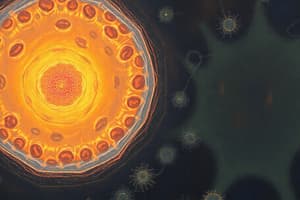Podcast
Questions and Answers
Which of the following correctly describes a differentiating feature of eukaryotes compared to prokaryotes?
Which of the following correctly describes a differentiating feature of eukaryotes compared to prokaryotes?
- Reproducing exclusively through binary fission
- Lacking genetic material
- Possessing membrane-bound organelles (correct)
- Presence of a cell wall made of peptidoglycan
In the 5-Kingdom classification system, which kingdom primarily consists of organisms that are prokaryotic?
In the 5-Kingdom classification system, which kingdom primarily consists of organisms that are prokaryotic?
- Monera (correct)
- Animalia
- Fungi
- Plantae
Which nutritional strategy is commonly associated with eukaryotic organisms?
Which nutritional strategy is commonly associated with eukaryotic organisms?
- Anaerobic respiration
- Photosynthesis using chlorophyll (correct)
- Chemosynthesis
- Heterotrophic nutrition through absorption (correct)
What distinguishes Archaebacteria from Eubacteria?
What distinguishes Archaebacteria from Eubacteria?
Which characteristic is NOT associated with eukaryotic cells?
Which characteristic is NOT associated with eukaryotic cells?
Which of the following correctly characterizes prokaryotic cells?
Which of the following correctly characterizes prokaryotic cells?
How do eukaryotic organisms primarily differ from prokaryotic organisms in terms of structure?
How do eukaryotic organisms primarily differ from prokaryotic organisms in terms of structure?
Which category of nutrition involves organisms that produce their own food from inorganic substances?
Which category of nutrition involves organisms that produce their own food from inorganic substances?
In which group would you classify organisms that are mostly unicellular and lack a defined nucleus?
In which group would you classify organisms that are mostly unicellular and lack a defined nucleus?
What type of reproduction is commonly associated with prokaryotic organisms?
What type of reproduction is commonly associated with prokaryotic organisms?
What is a key difference between prokaryotes and eukaryotes regarding nuclear membranes?
What is a key difference between prokaryotes and eukaryotes regarding nuclear membranes?
How many copies of chromosomal DNA do prokaryotes typically possess?
How many copies of chromosomal DNA do prokaryotes typically possess?
In the context of the 5-Kingdom Classification, which category do prokaryotes fall under?
In the context of the 5-Kingdom Classification, which category do prokaryotes fall under?
Which statement accurately distinguishes between archaebacteria and eubacteria?
Which statement accurately distinguishes between archaebacteria and eubacteria?
What distinguishes nutritional strategies in prokaryotic organisms?
What distinguishes nutritional strategies in prokaryotic organisms?
Flashcards are hidden until you start studying
Study Notes
Prokaryote vs. Eukaryote
- Cell Type: Prokaryotes lack a nucleus and other membrane-bound organelles. Eukaryotes have a nucleus and other membrane-bound organelles.
- Cell Wall: Many prokaryotes have a cell wall, while some eukaryotes (like plants and fungi) also have cell walls. Animal cells lack cell walls.
- Body Type: Prokaryotes are unicellular organisms. Eukaryotes can be unicellular or multicellular.
- Nutrition: Prokaryotes can be autotrophic (make their own food) or heterotrophic (consume food from other organisms). Eukaryotes can be autotrophic, heterotrophic, or a combination.
- Reproduction: Both prokaryotes and eukaryotes can reproduce asexually, but eukaryotes can also reproduce sexually.
Nuclear Membrane
- Prokaryotes lack a nuclear membrane, while eukaryotes have a nuclear membrane that encloses the cell's DNA.
- Prokaryotes have a single copy of chromosomal DNA, while eukaryotes have multiple copies of chromosomal DNA.
Studying That Suits You
Use AI to generate personalized quizzes and flashcards to suit your learning preferences.




